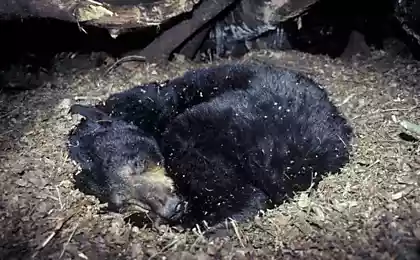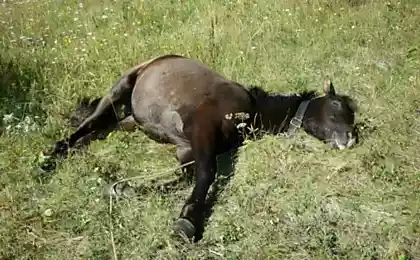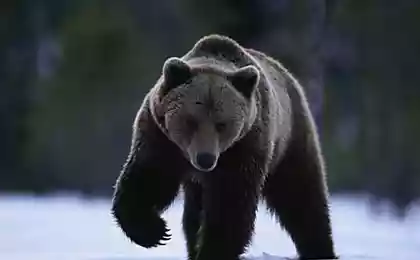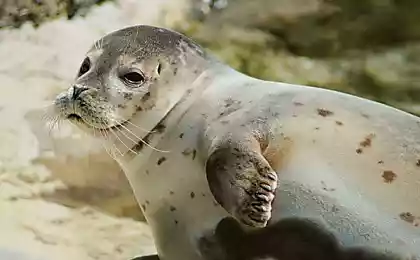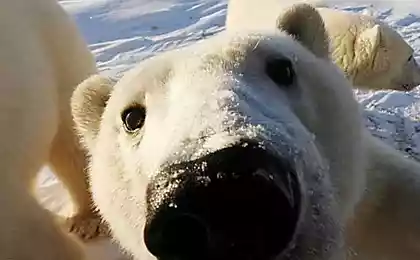973
Winter sleeping polar bears
Surprisingly, almost no sleep! That is sleeping-they normally like in the summer (only in summer, they sleep more). But in winter sleep they do not fall. ("Hibernation" of bears should be called winter sleep, this hibernation of bears is not, as body temperature is almost not falling, and at any moment they can Wake up.) Fall in hibernation and only pregnant suckling newborn young females. Other polar bears if and lie in the dens for a short while and not every year.
And surprisingly this is because the polar bear is the closest relative of the brown bear. They are descended from common ancestors who lived only 150 thousand years ago (for the evolution of species is recently). Even in the wild the species sometimes hybridize with each other. While their way of life polar bears differ from brown.
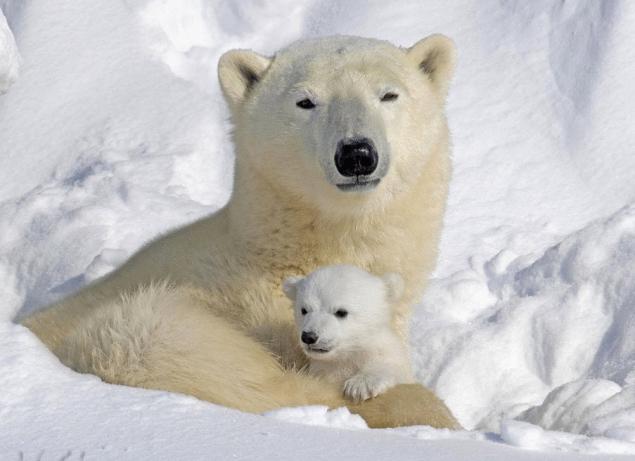
The main food of polar bears — ringed seals. These are the seals. Hunting polar bears on the ice. They either snatch a seal with a paw from the hole in the ice through which a seal breathes, or lie in wait and grab the seals that came out on the ice to rest. In many areas of the Arctic, where polar bears live, by the end of summer ice almost entirely melts. To hunt seals they can't do it. On land, most Arctic animals are able to escape from the polar bear and the sea — to swim away from him. Well, if you can find the carcass of a dead whale or walrus on the beach. And if not — then in the late summer and autumn bears are starving sometimes for several months. So in the winter they don't sleep and again start to hunt as soon as there is ice.
But the female has nowhere to go — they have to lie down in the den. After all bears the polar bear, like other bears are born small (they weight less than a kilogram) and blind; they are covered with a short fuzz. Usually females are having a lair on the beach, sometimes 50 km from the coast. Typically, the den, the bear does in the snow dune, but if a little snow, you can dig and burrow into the frozen ground. The female lays in the den just when the ice is melting, and hunting becomes difficult. Cubs are usually born in November-January, and remain in the den until February-March. Before the birth of cubs bear do is sleep, but during childbirth wakes up, and after birth to sleep she has already less. However, she still to the exit of the den is in a state of winter sleep does not eat, does not drink, doesn't pee or poop.
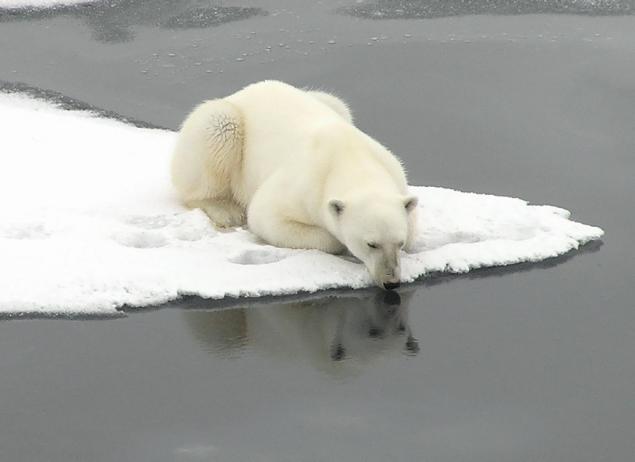
How the female manages to accumulate nutrients for a long sleep and for feeding the bears (and there are usually two)? It turns out that the pairing of polar bears occurs in the spring in April-may. Immediately after mating, pregnant females begin to eat that fall to become heavier at 200 kg mass is sometimes nearly doubled. The development of the embryo in the belly of the bear in spring is stopped at an early stage and continues until the autumn; they are at rest (called it the research of embryonic diapause). Apparently, this allows females to "fit" the beginning of embryo development at the time of the occurrence in the den; after all this time strongly depends on the conditions in the locality and even on the weather in a given year.
It is not very clear why not to eat all the polar bears. But for some reason they do not.
It is interesting that, apparently, in any time of the year during prolonged fasting polar bears as if "half asleep". In their blood falls sharply, the concentration of urea, which is typical for other species of bears during hibernation. Bears know how to use urea for the synthesis of amino acids and proteins of plasma (fluid part) of blood. (The concentration of proteins in plasma should be constant, otherwise, there are various problems with the transportation of fluids and the metabolism in the body.) In addition, the lower content of urea, the less we should bring it with urine, so less need to drink. Although the water in the form of snow usually readily available in the Arctic, to drink (or rather, is) it is energetically unprofitable — a lot of energy is lost in her warming.
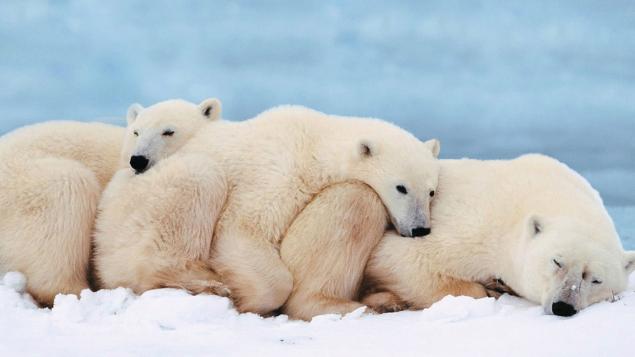
If the brown bear concentration of urea decreased, he becomes lethargic, not hungry and falls into a dream. But the polar bear in the presence of food again begins to eat and raises the concentration of urea to normal levels.
Interestingly, for the period of winter sleep, a polar bear somehow manages to lose almost no mass of bones and muscles. Usually in humans and other animals, their mass is drastically reduced during prolonged immobility, even when there is food; reduced bone mass and muscles and in other species of bears in the sleep period. But the polar bear spent nearly one only fat. It turns out that in some respects bears are more suited to winter sleep.
Source: /users/104
And surprisingly this is because the polar bear is the closest relative of the brown bear. They are descended from common ancestors who lived only 150 thousand years ago (for the evolution of species is recently). Even in the wild the species sometimes hybridize with each other. While their way of life polar bears differ from brown.

The main food of polar bears — ringed seals. These are the seals. Hunting polar bears on the ice. They either snatch a seal with a paw from the hole in the ice through which a seal breathes, or lie in wait and grab the seals that came out on the ice to rest. In many areas of the Arctic, where polar bears live, by the end of summer ice almost entirely melts. To hunt seals they can't do it. On land, most Arctic animals are able to escape from the polar bear and the sea — to swim away from him. Well, if you can find the carcass of a dead whale or walrus on the beach. And if not — then in the late summer and autumn bears are starving sometimes for several months. So in the winter they don't sleep and again start to hunt as soon as there is ice.
But the female has nowhere to go — they have to lie down in the den. After all bears the polar bear, like other bears are born small (they weight less than a kilogram) and blind; they are covered with a short fuzz. Usually females are having a lair on the beach, sometimes 50 km from the coast. Typically, the den, the bear does in the snow dune, but if a little snow, you can dig and burrow into the frozen ground. The female lays in the den just when the ice is melting, and hunting becomes difficult. Cubs are usually born in November-January, and remain in the den until February-March. Before the birth of cubs bear do is sleep, but during childbirth wakes up, and after birth to sleep she has already less. However, she still to the exit of the den is in a state of winter sleep does not eat, does not drink, doesn't pee or poop.

How the female manages to accumulate nutrients for a long sleep and for feeding the bears (and there are usually two)? It turns out that the pairing of polar bears occurs in the spring in April-may. Immediately after mating, pregnant females begin to eat that fall to become heavier at 200 kg mass is sometimes nearly doubled. The development of the embryo in the belly of the bear in spring is stopped at an early stage and continues until the autumn; they are at rest (called it the research of embryonic diapause). Apparently, this allows females to "fit" the beginning of embryo development at the time of the occurrence in the den; after all this time strongly depends on the conditions in the locality and even on the weather in a given year.
It is not very clear why not to eat all the polar bears. But for some reason they do not.
It is interesting that, apparently, in any time of the year during prolonged fasting polar bears as if "half asleep". In their blood falls sharply, the concentration of urea, which is typical for other species of bears during hibernation. Bears know how to use urea for the synthesis of amino acids and proteins of plasma (fluid part) of blood. (The concentration of proteins in plasma should be constant, otherwise, there are various problems with the transportation of fluids and the metabolism in the body.) In addition, the lower content of urea, the less we should bring it with urine, so less need to drink. Although the water in the form of snow usually readily available in the Arctic, to drink (or rather, is) it is energetically unprofitable — a lot of energy is lost in her warming.

If the brown bear concentration of urea decreased, he becomes lethargic, not hungry and falls into a dream. But the polar bear in the presence of food again begins to eat and raises the concentration of urea to normal levels.
Interestingly, for the period of winter sleep, a polar bear somehow manages to lose almost no mass of bones and muscles. Usually in humans and other animals, their mass is drastically reduced during prolonged immobility, even when there is food; reduced bone mass and muscles and in other species of bears in the sleep period. But the polar bear spent nearly one only fat. It turns out that in some respects bears are more suited to winter sleep.
Source: /users/104

